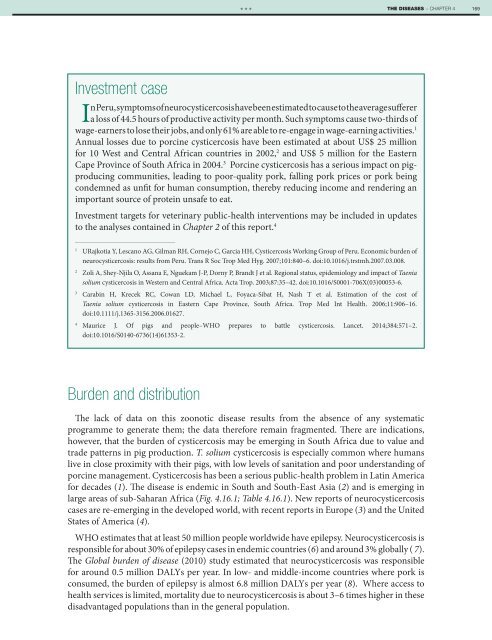1A9bnbK
1A9bnbK
1A9bnbK
Create successful ePaper yourself
Turn your PDF publications into a flip-book with our unique Google optimized e-Paper software.
***<br />
THE DISEASES − CHAPTER 4<br />
169<br />
Investment case<br />
In Peru, symptoms of neurocysticercosis have been estimated to cause to the average sufferer<br />
a loss of 44.5 hours of productive activity per month. Such symptoms cause two-thirds of<br />
wage-earners to lose their jobs, and only 61% are able to re-engage in wage-earning activities. 1<br />
Annual losses due to porcine cysticercosis have been estimated at about US$ 25 million<br />
for 10 West and Central African countries in 2002, 2 and US$ 5 million for the Eastern<br />
Cape Province of South Africa in 2004. 3 Porcine cysticercosis has a serious impact on pigproducing<br />
communities, leading to poor-quality pork, falling pork prices or pork being<br />
condemned as unfit for human consumption, thereby reducing income and rendering an<br />
important source of protein unsafe to eat.<br />
Investment targets for veterinary public-health interventions may be included in updates<br />
to the analyses contained in Chapter 2 of this report. 4<br />
_____________________<br />
1<br />
URajkotia Y, Lescano AG, Gilman RH, Cornejo C, Garcia HH, Cysticercosis Working Group of Peru. Economic burden of<br />
neurocysticercosis: results from Peru. Trans R Soc Trop Med Hyg. 2007;101:840–6. doi:10.1016/j.trstmh.2007.03.008.<br />
2<br />
Zoli A, Shey-Njila O, Assana E, Nguekam J-P, Dorny P, Brandt J et al. Regional status, epidemiology and impact of Taenia<br />
solium cysticercosis in Western and Central Africa. Acta Trop. 2003;87:35–42. doi:10.1016/S0001-706X(03)00053-6.<br />
3<br />
Carabin H, Krecek RC, Cowan LD, Michael L, Foyaca-Sibat H, Nash T et al. Estimation of the cost of<br />
Taenia solium cysticercosis in Eastern Cape Province, South Africa. Trop Med Int Health. 2006;11:906–16.<br />
doi:10.1111/j.1365-3156.2006.01627.<br />
4<br />
Maurice J. Of pigs and people–WHO prepares to battle cysticercosis. Lancet. 2014;384:571–2.<br />
doi:10.1016/S0140-6736(14)61353-2.<br />
Burden and distribution<br />
The lack of data on this zoonotic disease results from the absence of any systematic<br />
programme to generate them; the data therefore remain fragmented. There are indications,<br />
however, that the burden of cysticercosis may be emerging in South Africa due to value and<br />
trade patterns in pig production. T. solium cysticercosis is especially common where humans<br />
live in close proximity with their pigs, with low levels of sanitation and poor understanding of<br />
porcine management. Cysticercosis has been a serious public-health problem in Latin America<br />
for decades (1). The disease is endemic in South and South-East Asia (2) and is emerging in<br />
large areas of sub-Saharan Africa (Fig. 4.16.1; Table 4.16.1). New reports of neurocysticercosis<br />
cases are re-emerging in the developed world, with recent reports in Europe (3) and the United<br />
States of America (4).<br />
WHO estimates that at least 50 million people worldwide have epilepsy. Neurocysticercosis is<br />
responsible for about 30% of epilepsy cases in endemic countries (6) and around 3% globally ( 7).<br />
The Global burden of disease (2010) study estimated that neurocysticercosis was responsible<br />
for around 0.5 million DALYs per year. In low- and middle-income countries where pork is<br />
consumed, the burden of epilepsy is almost 6.8 million DALYs per year (8). Where access to<br />
health services is limited, mortality due to neurocysticercosis is about 3–6 times higher in these<br />
disadvantaged populations than in the general population.


